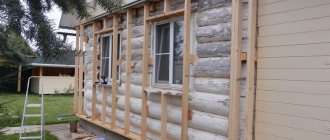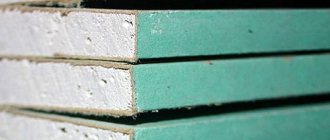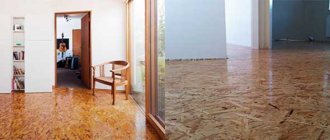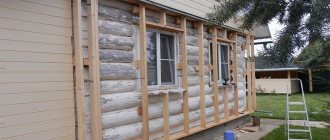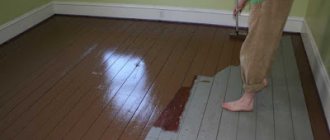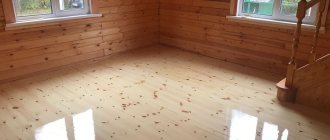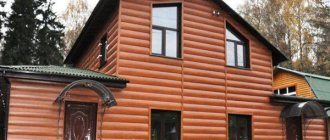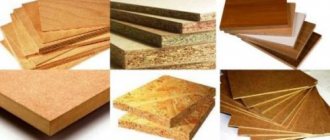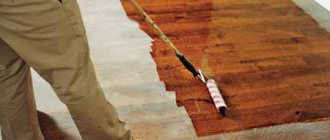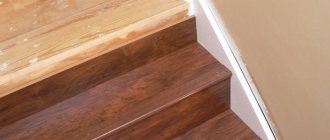Fastening cement bonded particle boards to a wooden frame
need to be prepared before attaching the slats to the façade. They beat off weak points and open up cracks. If the dowel gets into an unreinforced layer, the sheathing will wobble. Install the insulation on the wall, the material is fixed with dowels with wide caps (mushrooms).
Further actions:
- over the entire wall area attach the frame sheathingFor this purpose, galvanized profiles or wooden blocks treated with drying oil are used;
- during the installation process , verticality and horizontality are adjusted , a flat surface is formed in order to attach the DSP to the wooden frame without distortions;
- install windproof membrane so that there is a gap of at least 1 - 1.5 cm between it and the insulation;
- You cannot drill into the DSP directly with a self-tapping screw; you must first make holes in the panel with a diameter 0.5 mm smaller than the diameter of the hardware.
Valera
The voice of the construction guru
Ask a Question
The holes are made no closer than 10 mm from the edge with a pitch of 45 - 50 cm. The DSP sheets are fastened so that there is a gap of about 5 mm between them, which will subsequently be sealed with sealant. Countersink holes are made under the heads so that they are hidden in the body of the slab.
Fasteners for CBPB
More often, panels are fixed to frame elements using nails and self-tapping screws . Anchor bolts are used to fix the racks and cross members of the frame sheathing to the wall of the building.
The bolts can be metal or plastic, and the screws in them can be twisted or driven in. The length is chosen so that the hardware extends 40 - 50 mm into the concrete or brick. To fasten other parts, various hardware :
- Brackets and hangers from the drywall fastening system. With their help, wooden slats are leveled in a plane and verticality is coordinated.
- Self-tapping screw "flea" . Used when installing a frame made of galvanized profiles to connect metal profiles with hangers. In the case of wooden sheathing, wood screws are used.
- Dowel mushroom . These types of fasteners with large heads secure roll insulation, for example, mineral wool.
Valera
The voice of the construction guru
Ask a Question
Nails are used with a helical surface of the rod. If the slab moves after being secured, the nail may bend but will not cut it off. This is especially important for roof slopes if they are on a slight slope. The length of the hardware is taken so that it is 2.5 times the thickness of the DSP.
Advantages and disadvantages of a house made of fiberboard
Sheathing a frame house with DSP boards has its pros and cons . They are determined by technical characteristics and material properties.
Advantages of DSP cladding
DSPs are presented by manufacturers in several standard sizes. The most common is 2700x1250 mm with a thickness of 10-40 mm. The permissible humidity of the material is 6-12%, density is no more than 1300 kg/m2. With such characteristics, it has a whole set of advantages.
- Elasticity, bending strength (2500 MPa). They are determined by the alternation of layers of short and long chips , the quality of their processing before mixing with Portland cement.
- Flammability class G1 – low-flammable material .
- Rigidity. It is achieved by using high grade concrete and introducing special additives.
- Biological inertia. The cladding is not susceptible to mold and other harmful microorganisms and does not attract insects.
- Smooth surface. The roughness of the polished slabs is 0 mm, which facilitates finishing using adhesives and plaster.
- Effective heat saving. coefficient is 0.26 W/(m K).
The use of DSP in a frame house is also justified because it is an inexpensive, environmentally friendly, “breathable” material. Even if condensation collects in a multilayer wall, it is discharged outside.
Useful: SP 31-105-2002: basic requirements of the standard
Disadvantages of cement bonded particle boards
The disadvantage of cement bonded particle board is its heavy weight. With a size of 3200x1250 mm and a thickness of 16 mm, it weighs 80 kg. The greater the thickness, the greater the weight. It is inconvenient to transport such material and work with it at the height of the second floor.
A frame house made from DSP has pros and cons that need to be taken into account during construction and finishing. However, the disadvantages are many times less than the advantages. This makes DSP a worthy competitor to oriented strand boards, which contain harmful resins and practically do not allow air to pass through.
Seam sealing and finishing
To seal the seams, elastic putty is needed
Attention is paid to the joints of the panels , since moisture and steam cannot penetrate through the slab, but will enter the interior through an unprotected seam. Use sealing compounds or moisture-resistant putties. The products must adhere well to the surface of the slabs and not be destroyed by temperature changes and frost.
Putties are used that are elastic and will not crack under stress. Semicircular thinned edges (PLUK) are sealed without the use of reinforcing tape. In other cases, a reinforcing gasket is installed. Metal corners are mounted on the outer corners.
The slabs are finished with plaster or putty for facade work , but often such a layer is not necessary, since the slabs have an even geometry. Putty is often applied at joints or in places where the DSP had to be cut. Places of chips, defects, cracks are puttied.
Before applying a decorative coating or paint, the surface is treated with a deep penetration primer. If traces of efflorescence or rust appear on the surface of the slabs, they are washed off with soapy water.
Preparing the base
Metal frame
There are panels that do not require the installation of a frame, that is, they are self-supporting elements. To install them, a foundation will be sufficient. In cases where sandwich panels are not self-supporting, foundation preparation will be required. As a rule, such a base is a metal frame. During its assembly, you need to take into account a number of nuances:
- The foundation must be leveled horizontally, the maximum deviation should not exceed 3 mm;
- The distance between the vertical and horizontal profiles must correspond to the dimensions of the panels with a margin of 5 cm on each side to allow for smooth joining of elements and installation of decorative screens;
- When using wooden guides, they should be treated with antiseptic and fire-retardant compounds before installation to avoid further troubles.
You can, of course, make the panels yourself, but it is better to buy ready-made ones, since the panels from the factory have high quality insulation and glue.
Recommendations for working with DSP
You cannot carry the slabs by the edges, placing the sheet parallel to the ground, as the panel may break under its own weight. The panels are carried edge to ground and stored horizontally. The pads under the first sheet of wooden block are placed parallel after 0.5 m.
When cutting slabs with power tools, a large amount of dust is generated, so sawing is carried out outdoors , and respirators are used.
To make a hole for pipes, first cuts are made on the sheet , then part of the sheet is knocked out. The cutting tool must have teeth made of a special alloy that does not quickly become dull on cement. For a grinder or circular saw, use a diamond wheel.
Which paint to choose for DSP on the facade
After completing the installation work, the ideal facade of the house is obtained. You can get rid of the dull gray color with basic coloring. DSP panels for exterior finishing of a house are painted with acrylic, latex or silicate facade paints.
Acrylic paint is often used to paint DSP facades. Thanks to the plastic resin included in the composition, it fits well on the concrete surface. Polymers ensure its resistance to any climatic conditions and natural phenomena.
Another option is latex paint. Its latex polymers provide increased stability. Silicone, polyvinyl and other similar components provide additional strength. As a result of painting, a durable film is formed that easily resists any atmospheric conditions and can be washed, if necessary, with any detergents.
Silicate paint is produced on the basis of liquid glass. It has excellent adhesive properties and penetrates into the structure of the material. As a result of staining, high biological stability of the surface is ensured, as well as resistance to aggressive environments, including acid rain. The use of high-quality DSP for façade cladding followed by painting allows you to transform a new house and restore an old building. The resulting result will please the eye for many years and will extend the service life of the building.
Features of installation and surface care
Summarizing the above, it is necessary to note a number of features of installation and care of this material. So, for example, before proceeding with the installation of walls, it is necessary to ensure reliable insulation of the lower sandwich panels from moisture penetration from the foundation of the building.
The first layer needs to be laid bitumen cardboard (roofing felt), and on top of it - a layer of mineral wool. The width of such a “layer cake” should exceed the width of the panel wall by 10 mm on each side, and the mineral wool should be laid in such a way that it completely fills the grooves of the lower panels.
The protective coating on sandwich panels, which is applied during their production, is quite unstable, so special care should be taken during installation. After completion of construction, during the operation of the building, it is necessary to regularly inspect the surface of the panels, and if damage is detected, restore them using special repair dyes.
Dirt is easily removed with a medium-hard brush dipped in soapy water. The factory protective film must be removed immediately upon completion of installation work, but this should only be done in dry and cool weather.
Conclusion
Now you know that DSP is excellent for finishing facades; the material is easy to use, durable and lasts for at least half a century. The video in this article will clearly show some important points of the work process, and if you still do not fully understand the topic, then write all questions in the comments under this review.
November 18, 2016
If you want to express gratitude, add a clarification or objection, or ask the author something, add a comment or say thank you!
- February 27, 2022
- February 21, 2022
- February 20, 2022
- February 16, 2022
- February 15, 2022
- February 13, 2022
Latest replies on the forum
- Cinder block walls
How to cover cinder block wallsQuestion added: February 09, 2022 - 19:32
views
- Walls
Hello. Can you tell me how to put decorative stone on a putty wall?Question added: August 03, 2022 - 12:25
views
- Question about wall cladding in the bathroom
Good day. Having studied quite a lot of information, I could not come to a clear conclusion. Maybe you can help me. Situation …Question added: May 20, 2022 - 11:50
views
- Mystic... scary
Dear forum users, I want to know if anyone has had anything similar... I’ll say right away that alcohol and nothing else that clouds my brain...Question added: October 20, 2022 - 08:44
views
You might be interested
